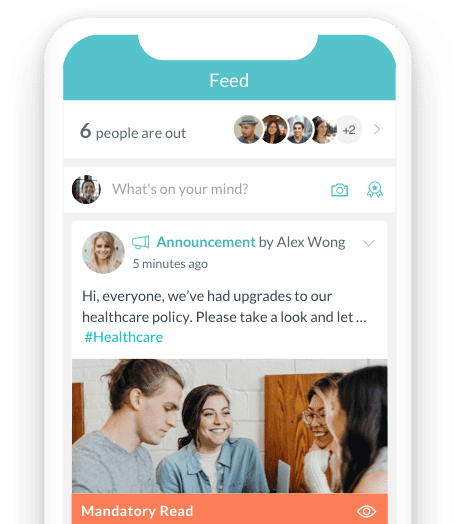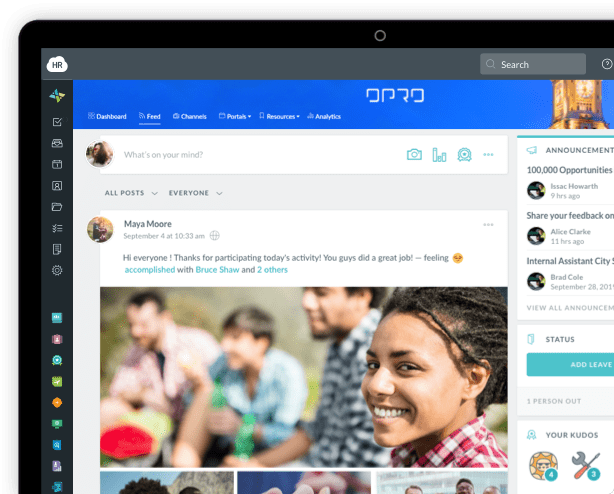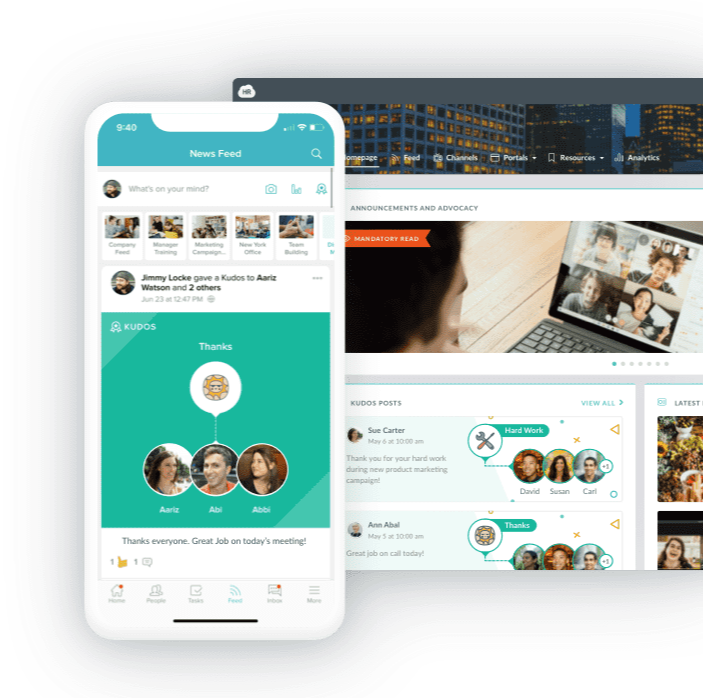Making the Right Difference by Recognition and Rewards Policy
.png)


 Cut onboarding time
by 60%—here's the
Ultimate Checklist
that helped do it.
Cut onboarding time
by 60%—here's the
Ultimate Checklist
that helped do it.

Employee recognition and rewards have emerged as crucial components of a successful business. In today's competitive landscape, organizations must prioritize the engagement and satisfaction of their employees to drive productivity and retain top talent. A well-designed employee recognition and rewards program can not only boost morale but also foster a sense of purpose and belonging among employees.
Recognizing and rewarding the employees at the workplace for their dedication and effort can be a powerful tool to boost their morale, enhance performance, and foster a positive work environment. It’s therefore crucial to establish a well-defined Recognition and Rewards Policy that ensures the right difference is made, and that the effort and resources invested yield the desired results.
The Importance of Employee Recognition and Rewards
Employee recognition and staff rewards programs have a profound impact on the overall success as well as performance of an organization. When employees feel a sense of appreciation and value for their contributions, they will be more committed and engaged to their work. Here are some of the important advantages for an organization that implements an effective and result oriented employee recognition and rewards program:
- Increased Employee Engagement
Recognition programs promote an inclusive and positive work environment where employees feel acknowledged and appreciated. When employees are recognized for their efforts, they will become more engaged in their workplace and committed to achieving organizational goals.
- Improved Job Satisfaction
Recognition and rewards contribute to higher job satisfaction among employees. When employees feel rewarded and appreciated for their hard work, they experience a sense of true fulfillment and purpose in their roles.
- Enhanced Employee Retention
Employee turnover can be a liability for organizations, in terms of both financial resources as well as talent poll loss. With the implementation of a robust recognition and rewards program, organizations can improve employee retention rates, reducing recruitment and training costs.
- Increased Productivity and Performance
When employees feel that they are being valued and if they feel motivated, they will feel more energized to go above and beyond in their work. Recognition and rewards programs can drive productivity and performance by incentivizing employees to consistently perform at their best.
- Strengthened Team Dynamics
Recognition programs that incorporate peer-to-peer appreciation foster a sense of camaraderie and collaboration among team members. By encouraging employees to acknowledge their colleagues' contributions, organizations can build strong and cohesive teams.

Designing an Effective Employee Recognition and Rewards Program
To ensure the success of an employee recognition and rewards program, organizations need to develop a well-thought-out strategy. Here are key steps to design and implement an effective program:
- Define Your Vision
Before implementing a recognition and rewards program, it is essential to define your organization's vision and goals. Consider the specific objectives that you plan to achieve through the program and align them with your overall business strategy.
- Build a Team
Form a dedicated team responsible for the implementation and management of the recognition and rewards program. This team should be passionate about fostering a positive work culture and believe in the organization's values.
- Define Recognition Criteria
To make recognition meaningful, establish clear criteria for rewarding and appreciating employees. Identify specific behaviors, achievements, or milestones that warrant recognition and communicate them to employees. Recognition and rewards are not only good for employees, but also help you create a culture focused on teamwork and excellence. In this regard, Workmates by HR Cloud is an effective employee recognition software & rewards platform which helps with everything you need to make your employees feel appreciated and valued.
- Choose the Right Rewards
Select a combination of cash and non-cash rewards that align with your organization's values and employee preferences. Consider personalized gifts, experiences, professional development opportunities, and symbolic awards to make rewards more meaningful. By using Workmates' solution by HR Cloud, a powerful and effective employee recognition software, you can automate and customize rewards to ensure no crucial event or milestone goes unrecognized. This software helps you streamline Rewards throughout the Employee Journey by celebrating every occasion, right from joining the organization to career growth and personal milestones.
- Be Inclusive
Recognition and rewards policies should be inclusive, covering all levels of the organization, from top management to entry-level employees. It’s important to ensure that no one is left out, and that contributions at every level are acknowledged and appreciated.

- Align with Values and Objectives
The policy should be closely aligned with the organization's values and objectives. Rewards should be tied to behaviors and outcomes that support the company's mission and vision, reinforcing the desired culture.
- Transparency and Consistency
A successful policy should have high transparency and be applied consistently. Employees need to understand how recognition and rewards are earned and distributed. Inconsistencies can result in feelings like unfairness and demotivation.
- Tailored Approach
Recognize that different employees have unique preferences and motivations. One size doesn't fit all. Tailor recognition and rewards to suit individual and team preferences, whether through monetary incentives, public recognition, flexible work options, or personal growth opportunities.
- Timeliness
Recognition should be timely. Don't wait for annual reviews to acknowledge excellent work. Immediate recognition can lead to greater impact on an employee's motivation and job satisfaction.
- Ensure Successful Implementation
Introduce the recognition and rewards program to employees through effective communication channels. Gain buy-in from managers and ensure they actively advocate for the program. Align the program's objectives with the organization's values and promote employee participation.
- Measure and Revisit
Regularly measure the impact of the recognition and rewards program on employee engagement, productivity, and overall business results. Gather feedback from employees using surveys or focus groups that can help you identify areas of improvement and adapt the program accordingly.
Social Intranet Software that Encourages Employee Communication

- Communication
Effective communication is key. Clearly convey the policy to all employees, ensuring they understand how it works, the types of recognition and rewards available, and the criteria for earning them. Workmates internal communication software provides all the communication tools your organization needs to create an exceptional employee experience. This helps to not only increase employee engagement, but also morale, and productivity.
- Budget Consideration
Ensure that the organization allocates a reasonable budget for recognition and rewards. It's important to strike a balance between providing meaningful rewards and maintaining the financial health of the company.
Types of Employee Recognition and Rewards Programs
There are different types of employee recognition and rewards programs that organizations can implement for motivating their employees. Here are some popular options:
- Employee of the Month/Year
Recognize outstanding employees on a monthly or yearly basis for their exceptional contributions to the organization. This program encourages healthy competition and recognizes individuals who excel in their roles consistently.
- Peer-to-Peer Recognition
Encourage employees to appreciate as well as acknowledge the achievements of their colleagues' through a peer-to-peer recognition program. This fosters better teamwork and strengthens relationships within the organization. For example, with Workmates' Peer-to-Peer Recognition solution by HR Cloud, any employee can give a digital “kudos” to recognize a peer’s hard work or achievement. Kudos points are tracked and can be redeemed for gift cards, corporate items, or other “thank you.”
- Milestone Celebrations
Celebrate significant milestones in employees' careers, such as work anniversaries, to show appreciation for their long-term commitment as well as the loyalty of employees to the organization.
- Personalized Gifts and Experiences
Reward employees with personalized gifts or experiences that cater to their individual preferences and interests. This demonstrates that the organization values employees' uniqueness and appreciates their contributions.
- Professional Development Opportunities
Invest in employees' growth as well as development where they receive opportunities for learning and skill enhancement. This can include sponsoring conferences, workshops, or relevant online courses that align with their roles.
- Team-based Rewards
Recognize and reward entire teams for their collective achievements and successful collaboration. This approach promotes a sense of unity and encourages teamwork within the organization.
“Our staff has praised the increased communications level Workmates delivers. We use it to communicate important project matters and give staff specific ‘kudos’ or even recognize their birthdays. More importantly, we use Workmates to clarify important project details that needed rapid dissemination among the entire team.”

Implementing Technology for Employee Recognition and Rewards
Leveraging technology can enhance the effectiveness and efficiency of employee recognition and rewards programs. Here are a few ways in which technology can be utilized:
- Recognition Platforms
Implement recognition software that allows employees to give and receive recognition in a streamlined and accessible manner. These platforms enable real-time recognition and provide a central hub for tracking and managing the program. Workmates software helps to empower employees through company-wide recognition. You can make your employees feel valued with a culture of appreciation.
- Gamification
Incorporate gamification elements into the recognition and rewards program to make it more engaging and interactive. This can involve leaderboards, badges, and challenges that encourage healthy competition and motivate employees to strive for excellence.
- Social Integration
Integrate recognition and rewards programs with existing internal communication and collaboration tools, such as enterprise social networks. This allows for seamless sharing of achievements and promotes a culture of appreciation.
- Data Analytics
Utilize data analytics to measure how effective the rewards and recognition program is. Analyze employee feedback, participation rates, and performance metrics to gain insights and make data-driven decisions for program improvement.
Conclusion
Employee recognition and rewards programs are crucial tools to create a positive work culture, increase employee engagement, and acheive organizational success. By defining clear objectives, aligning with the organization's values, and being inclusive and transparent, you can create a policy that truly makes the right difference within your organization. Regular review and adaptation of the policy will ensure it remains effective in a changing work environment, ultimately benefiting both employees and the organization as a whole.
Through the strategic use of technology and thoughtful rewards, organizations can build strong teams, improve retention rates, and ultimately boost productivity and profitability. Start implementing an effective employee recognition and rewards program today to unlock the full potential of your workforce.
Author Bio:
This article is written by a marketing team member at HR Cloud. HR Cloud is a leading provider of proven HR solutions, including recruiting, onboarding, employee communications & engagement, and rewards & recognition. Our user-friendly software increases employee productivity, delivers time and cost savings, and minimizes compliance risk.
Keep Reading
15 Proven Ways to Create a Healthy Work Environment (2026 Guide)
A healthy work environment is a workplace where employees experience psychological
Best Workday Alternatives for Mid-Market Companies in 2026: Complete HRIS Comparison Guide
"We implemented Workday and our HR team still can't figure out half the features six
Company Culture Software: How to Build a Thriving Workplace in 2026
Ask any business leader what drives lasting organizational success, and you'll hear
Like What You Hear?
We'd love to chat with you more about how HR Cloud® can support your business's HR needs. Book Your Free Demo

Build a Culture of Recognition. Boost Engagement. Guaranteed.
Workmates empowers employees to stay informed, connected, and appreciated—whether they’re on the front line, in the office, or remote. Recognition drives 12x higher engagement.Trusted by industry leaders in every sector




Cut Onboarding Costs by 60%.
Take the confusion and follow-ups out of onboarding with automated workflows, digital forms, and structured portals—so new hires ramp faster 3X quicker.Trusted by industry leaders in every sector






